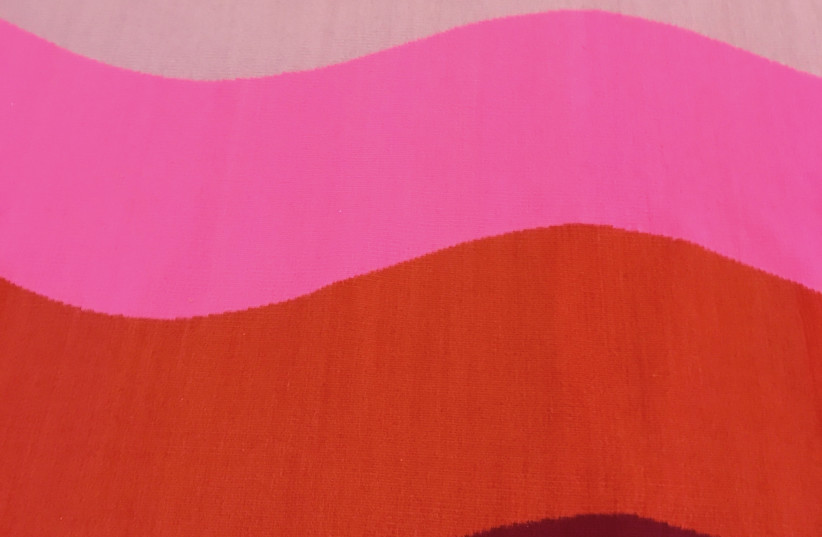In the forty plus years that Polly Apfelbaum has been a member of the international arts community, a lot has changed. Whereas, once the arts were divided into clear categories that rarely intersected such as design, craft, painting and sculpture, today, largely thanks to the holistic approach of artists like Apfelbaum, the boundaries are less important and inclusion is on the rise.
This progress can be seen and felt in Apfelbaum’s solo show at Magasin III in Jaffa, which is currently on display. Entitled Red Desert, Red Mountain, Red Sea, the exhibition features new and old works by the renowned American artist. There are ceramic paintings, rugs, which Apfelbaum refers to as fallen paintings, wall paintings and a collection of ceramic beads neatly laid out in woven baskets. The show, like Apfelbaum, brings together many different materials, colors, techniques and approaches into a cohesive, lively and celebratory experience.
When I arrive to meet Apfelbaum, I find her in the Magasin III office, sipping a latte. It is mid-morning and Apfelbaum is having a slow start following the opening of the exhibition the night before. Beside her sit woven baskets, made by local collective Kuchinate, filled with vintage embroidery threads of red and cream tones, neatly color coded, and small burgundy velvet flower shaped beads. As soon as we sit down, she offers to make me a necklace out of the materials at her hands. “I was making these last night at the opening,” she says.
Apfelbaum, 67, was born and raised in Pennsylvania and cites her hometown as a continual source of inspiration. She graduated from the Tyler School of Art and then moved to New York City, where she has resided for over forty years.

“My life as an artist began when I moved to New York,” she says.
Her works have been widely exhibited throughout the United States, Europe and Asia since the 1980’s. Since the beginning of her career, Apfelbaum has refused to limit herself to one media or material. Instead, she has embarked upon a constant quest to explore, study and incorporate different techniques. “When I went to art school, everything was so separate. If you were a painter, you didn’t take a ceramics class. Everything was very linear. I wanted to explore and create a language, and I was interested in a lot of different ideas and materials. I wanted to bring it all in.” Apfelbaum goes on to mention the types of craft that are seen as women’s work and how they were excluded from the fine arts elite. “I had to sneak in craft and color.”
Apfelbaum is wearing an oversized grey sweater with a yellow smiley face on the front, a mid-length pencil skirt, wool cap and maroon velvet loafers. There is nothing of the haughty visual artist in Apfelbaum’s demeanor, rather an immediate generosity and openness. “The thread is from my collection and the rest I bought in thrift stores along the way,” she says. It seems Apfelbaum has many collections. The beads in the exhibition are from another collection, one developed over several months in residency at Arcadia University. “For the last two years, I’ve been working with the ceramics department at the university. It got me through the COVID-19 period,” she explains. “I did many tests with ceramics. I like that part of the studio is in the show.” In fact, guests of the gallery are encouraged to touch the textured and multicolored beads, offering a rare opportunity to interact with the artifacts in such a setting.
On the floor a few meters away lies Red Desert, a velvet rug stained with black pigment, which Apfelbaum made nearly thirty years ago. The piece has been in the Magasin III Museum collection since 1997 and this engagement was the first time that she had seen the work since. “I’m seeing this piece I hadn’t seen or installed in thirty years and it’s nice to ask myself ‘why did you do that?’ and remember that there was a certain logic to it.”
In each exhibition, Apfelbaum allows the location to impact her choices. She currently has another show up in Lucerne, which is completely different, she says. In Jaffa, for the first time, Apfelbaum was moved to explore waves. In most of her installations and wall painting until now, she has favored straight, clean lines. Yet, in Jaffa, she found herself pulled towards a more fluid geometry.
Another nod to the location is in the second large Fallen Painting. Here, amidst waves of red hues painstakingly woven by Apfelbaum’s longtime collaborators in Oaxaca, Mexico, lies a large white flower. “It is an Anemone (Kalanit in Hebrew),” she explains. “I believe flowers carry a lot of weight and are very beautiful. Mostly, my rugs have been abstract, but I wanted there to be something connected to the place and I found out that the Anemone is the state flower of Israel. I like the idea that everything is red and the flower, which in real life is red, is white here.”
Two of the walls are lined with ceramic paintings, another of Apfelbaum’s signature inventions. Each one boasts a different texture, some evoke the sun and others the sea. Together, the pieces sing a song of vibrancy, positivity and depth.
Red Desert, Red Mountain, Red Sea is currently on display at Magasin III in Jaffa. For more information, visit www.magasin3.com.
